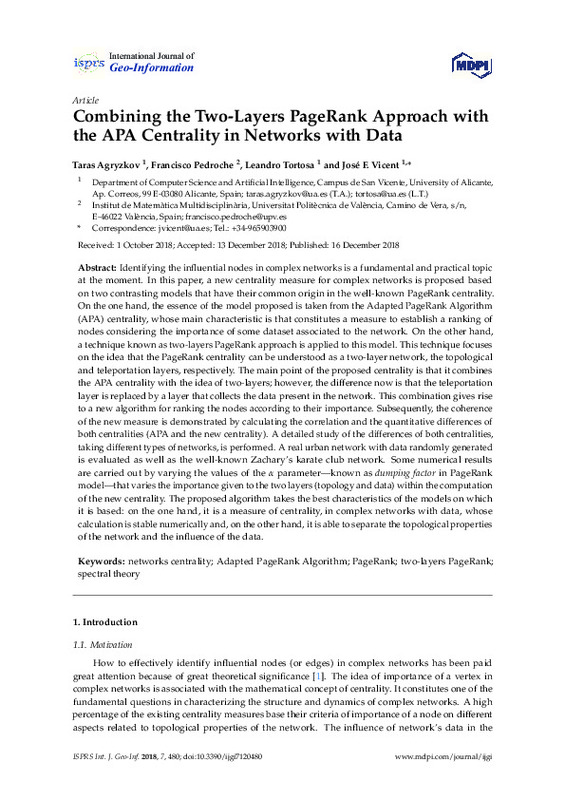Crucitti, P., Latora, V., & Porta, S. (2006). Centrality measures in spatial networks of urban streets. Physical Review E, 73(3). doi:10.1103/physreve.73.036125
Bonacich, P. (1991). Simultaneous group and individual centralities. Social Networks, 13(2), 155-168. doi:10.1016/0378-8733(91)90018-o
Stephenson, K., & Zelen, M. (1989). Rethinking centrality: Methods and examples. Social Networks, 11(1), 1-37. doi:10.1016/0378-8733(89)90016-6
[+]
Crucitti, P., Latora, V., & Porta, S. (2006). Centrality measures in spatial networks of urban streets. Physical Review E, 73(3). doi:10.1103/physreve.73.036125
Bonacich, P. (1991). Simultaneous group and individual centralities. Social Networks, 13(2), 155-168. doi:10.1016/0378-8733(91)90018-o
Stephenson, K., & Zelen, M. (1989). Rethinking centrality: Methods and examples. Social Networks, 11(1), 1-37. doi:10.1016/0378-8733(89)90016-6
Szell, M., Lambiotte, R., & Thurner, S. (2010). Multirelational organization of large-scale social networks in an online world. Proceedings of the National Academy of Sciences, 107(31), 13636-13641. doi:10.1073/pnas.1004008107
Calabrese, F., Colonna, M., Lovisolo, P., Parata, D., & Ratti, C. (2011). Real-Time Urban Monitoring Using Cell Phones: A Case Study in Rome. IEEE Transactions on Intelligent Transportation Systems, 12(1), 141-151. doi:10.1109/tits.2010.2074196
Chen, D., Lü, L., Shang, M.-S., Zhang, Y.-C., & Zhou, T. (2012). Identifying influential nodes in complex networks. Physica A: Statistical Mechanics and its Applications, 391(4), 1777-1787. doi:10.1016/j.physa.2011.09.017
Zhou, Y.-B., Lü, L., & Li, M. (2012). Quantifying the influence of scientists and their publications: distinguishing between prestige and popularity. New Journal of Physics, 14(3), 033033. doi:10.1088/1367-2630/14/3/033033
Porta, S., Crucitti, P., & Latora, V. (2006). The network analysis of urban streets: A dual approach. Physica A: Statistical Mechanics and its Applications, 369(2), 853-866. doi:10.1016/j.physa.2005.12.063
Jiang, B. (2009). Ranking spaces for predicting human movement in an urban environment. International Journal of Geographical Information Science, 23(7), 823-837. doi:10.1080/13658810802022822
Bonacich, P. (1987). Power and Centrality: A Family of Measures. American Journal of Sociology, 92(5), 1170-1182. doi:10.1086/228631
Boldi, P., & Vigna, S. (2014). Axioms for Centrality. Internet Mathematics, 10(3-4), 222-262. doi:10.1080/15427951.2013.865686
Freeman, L. C. (1977). A Set of Measures of Centrality Based on Betweenness. Sociometry, 40(1), 35. doi:10.2307/3033543
Brandes, U. (2001). A faster algorithm for betweenness centrality*. The Journal of Mathematical Sociology, 25(2), 163-177. doi:10.1080/0022250x.2001.9990249
Haveliwala, T. H. (2003). Topic-sensitive pagerank: A context-sensitive ranking algorithm for web search. IEEE Transactions on Knowledge and Data Engineering, 15(4), 784-796. doi:10.1109/tkde.2003.1208999
Berkhin, P. (2005). A Survey on PageRank Computing. Internet Mathematics, 2(1), 73-120. doi:10.1080/15427951.2005.10129098
García, E., Pedroche, F., & Romance, M. (2013). On the localization of the personalized PageRank of complex networks. Linear Algebra and its Applications, 439(3), 640-652. doi:10.1016/j.laa.2012.10.051
Langville, A., & Meyer, C. (2004). Deeper Inside PageRank. Internet Mathematics, 1(3), 335-380. doi:10.1080/15427951.2004.10129091
Bianchini, M., Gori, M., & Scarselli, F. (2005). Inside PageRank. ACM Transactions on Internet Technology, 5(1), 92-128. doi:10.1145/1052934.1052938
Migallón, H., Migallón, V., Palomino, J. A., & Penadés, J. (2018). A heuristic relaxed extrapolated algorithm for accelerating PageRank. Advances in Engineering Software, 120, 88-95. doi:10.1016/j.advengsoft.2016.01.024
Agryzkov, T., Oliver, J. L., Tortosa, L., & Vicent, J. F. (2012). An algorithm for ranking the nodes of an urban network based on the concept of PageRank vector. Applied Mathematics and Computation, 219(4), 2186-2193. doi:10.1016/j.amc.2012.08.064
Agryzkov, T., Tortosa, L., & Vicent, J. F. (2016). New highlights and a new centrality measure based on the Adapted PageRank Algorithm for urban networks. Applied Mathematics and Computation, 291, 14-29. doi:10.1016/j.amc.2016.06.036
Agryzkov, T., Tortosa, L., Vicent, J. F., & Wilson, R. (2017). A centrality measure for urban networks based on the eigenvector centrality concept. Environment and Planning B: Urban Analytics and City Science, 46(4), 668-689. doi:10.1177/2399808317724444
Conti, M., & Kumar, M. (2010). Opportunities in Opportunistic Computing. Computer, 43(1), 42-50. doi:10.1109/mc.2010.19
Zhang, Y., Song, L., Jiang, C., Tran, N. H., Dawy, Z., & Han, Z. (2017). A Social-Aware Framework for Efficient Information Dissemination in Wireless Ad Hoc Networks. IEEE Communications Magazine, 55(1), 174-179. doi:10.1109/mcom.2017.1600029cm
Boccaletti, S., Bianconi, G., Criado, R., del Genio, C. I., Gómez-Gardeñes, J., Romance, M., … Zanin, M. (2014). The structure and dynamics of multilayer networks. Physics Reports, 544(1), 1-122. doi:10.1016/j.physrep.2014.07.001
Kivela, M., Arenas, A., Barthelemy, M., Gleeson, J. P., Moreno, Y., & Porter, M. A. (2014). Multilayer networks. Journal of Complex Networks, 2(3), 203-271. doi:10.1093/comnet/cnu016
Pedroche, F., Romance, M., & Criado, R. (2016). A biplex approach to PageRank centrality: From classic to multiplex networks. Chaos: An Interdisciplinary Journal of Nonlinear Science, 26(6), 065301. doi:10.1063/1.4952955
Zachary, W. W. (1977). An Information Flow Model for Conflict and Fission in Small Groups. Journal of Anthropological Research, 33(4), 452-473. doi:10.1086/jar.33.4.3629752
[-]









